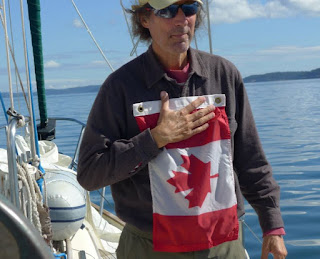 The last four years we've been spending November through June in Mexico, returning to the states for the summer and fall months. In Mexico, in May, as we sweated in the boat, we'd yearn for those cool, moist days in the Pacific Northwest and we'd remember fondly hiking in the greenery and inhaling the sweet smells of the forest.
The last four years we've been spending November through June in Mexico, returning to the states for the summer and fall months. In Mexico, in May, as we sweated in the boat, we'd yearn for those cool, moist days in the Pacific Northwest and we'd remember fondly hiking in the greenery and inhaling the sweet smells of the forest.Now that we are here in the moist northwest we are growing our own greenery in the form of mold, mildew, moss, and lichen. I'd forgotten (or suppressed) the memories of just how cold and damp and dark it is here in Cascadia in the winter. Now it is coming back to us as we dash through the drizzle, down the dock, up the ramp, and into the cold bathroom ashore. ......OK, I must admit that the photo above is of an old boat on H dock. Somebody has been paying moorage on this thing for many years as the moss and lichen proliferates......
 |
| Tesla at gift giving. |
 |
| Ezrah on the uke. |
Fabric must not touch the hull. Paper cannot touch the hull. Clothing is best kept in sealed plastic bags. Air flow cannot be restricted and the dehumidifier must run constantly. We replace the calcium chloride moisture absorbers as needed (Starbrite, DampRid, Dry-Z). When we cook we open a hatch to let the steam out and when the sun (rarely) comes out, we open everything up.
Add to these chores, the normal to-do list on a boat and you'll see that we don't have an abundance of spare time. Granted, I do sleep about 10 hours a night and surf the web another 5 hours, but really, we'd be hard pressed if we had actual full time jobs we had to attend to.
 |
| The Annabel Lee is for sale. |
It's nice being able to visit with Connie's daughter and son and to go out occasionally and see friends performing at local music venues. We put together a little web page for Connie to showcase some of her music samples and she's looking for gigs locally.
 |
| Pretty sweet, eh? |
In the meantime, we are ticking off the to-do list. Connie is almost finished with the cockpit enclosures. All that remains of that job is to install the bottom snaps. Already we notice how much warmer it is in the cockpit and aft cabin area.
 I'm getting ready to pull out our old 1981 Wilcox Crittenden Imperial 51 toilet to take up to Tucker at Marine Sanitation & Supply so he can rebuild the intake pump. Many parts are no longer available for this old bronze beauty but Tucker says he can cobble together what's needed to get her back in shape. Sure, we could buy a new model ($500 - $600) but why not re-use if we can and none of the new heads are as tough as the old Imperial 51.
I'm getting ready to pull out our old 1981 Wilcox Crittenden Imperial 51 toilet to take up to Tucker at Marine Sanitation & Supply so he can rebuild the intake pump. Many parts are no longer available for this old bronze beauty but Tucker says he can cobble together what's needed to get her back in shape. Sure, we could buy a new model ($500 - $600) but why not re-use if we can and none of the new heads are as tough as the old Imperial 51.I've got to hank off the Genoa to take it to Jim Kitchen at Puget Sound Sails so he can give it a good inspection and repair a few UV damaged threads. And he'll try to clean up a few grease marks where lubricants have leeched through the foil and onto the sail fabric. When we repaired that stuck sheave at the top of the mast after our Hawaii crossing we applied plenty of spray lubricant to the halyard. Some of that lubricant found its way down that foil, reacted with the aluminum and escaped into the fabric. I'm trying to think of a place big, flat and dry enough to fold up that 500 square feet of sail once we bring it down...
Meanwhile, when the rain pours down, we keep the Tupperware under the dripping hatches and continue with our moisture removal regimen. The fronts come roaring in from the west, one after the other.
When we do see some clearing, the temperature plummets and we crank up the heaters. I'm sure my electric bill will be outstanding. The other morning we woke up and found the AC power had failed. The shore power cord had shorted out where it plugs into the boat. Since it was a Sunday and the marine stores were closed, I used a couple of 30 amp adapters and a sturdy extension cord to keep us powered. The next day when I replaced the temporary rig with a Marinco heavy duty 30 amp marine cord, I found the little extension cord hot and "melty" from the amp draw of our two 1500 watt heaters. I'm glad we ran them on the 800 watt setting that night. Watch out! This is the kind of thing that starts electrical fires, a leading cause of boat loss.
You might ask, "Are you re-thinking your decision to winter over in Cascadia?" The answer is, "Well....Yes".
“That which does not kill us, makes us stronger.” Friedrich Nietzsche












































